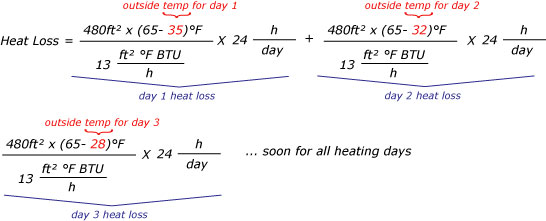7.4: Residental Heat Loss (IV)
- Page ID
- 47194
Calculating Hourly Heat Loss
As we have learned, most heat is lost through a house's walls through conduction. One of the three factors that affect heat loss is a wall's capacity to resist heat loss.
We will now look at how to calculate the rate of heat loss of the walls of a house, using the formula
\[ Hourly \, Heat \, Loss = \dfrac{Area * (Temperature \, Difference)}{R-value} \]
where the area has units of ft2, temperature difference has units of °F, and R-value has units of ft2 °F h/BTUs to obtain a heat loss with units of BTUs/h.
From the above equation it can be seen that once the house is built, these two variables will NOT change:
- The area of the walls
- The R-value of the walls
The only variable that will change is the temperature difference between inside and outside.
Example Problem
The following video provides an example problem with the solution.
Calculating Daily Heat Loss
To calculate daily heat loss, you would simply multiply the hourly heat loss, determined in equation 7.4.1, by 24 hours, i.e.,
\[ Daily \, Heat \, Loss = \dfrac{Area * (Temperature \, Difference)}{R-value} * 24 \, h/day \]
where daily heat loss would have units of BTUs/day.
Example Problem
Example 1
What is the hourly and daily heat loss of a 15-ft by 15-ft room with an 8-ft ceiling, with all surfaces insulated to R13, with inside temperature 65°F and outside temperature 25°F?
- Answer
-
Determine the surface area by first computing the area of one wall, i.e.,
\[ Area \, of \, one \, wall = 8 * 15 = 120 \, ft^2 \nonumber\]
Then multiply this area by 4 to obtain the total area of the room, i.e.,
\[ Area \, of \, room = 4 * 120 = 480 \, ft^2 \nonumber\]
To obtain the hourly heat loss, use equation 7.4.1, i.e.,
\[ Hourly \, Heat \, Loss = \dfrac{480 * (65 - 25)}{13} = 1.477 \dfrac{BTUs}{h} \nonumber\]
Once we know the heat loss rate per hour, we can determine the heat loss per day by using equation 7.4.2, i.e.,
\[ Daily \, Heat \, Loss = 1.477 \dfrac{BTUs}{h} * 24 \dfrac{h}{day} = 35,448 \dfrac{BTUs}{day} \nonumber\]
Calculating Annual Heat Loss
In the previous calculations, we determined hourly and daily heat loss. How do we calculate annual or seasonal heat loss?
Since the temperature outside the house may not remain the same day after day, the heat loss will vary by the day. Thus, to obtain the heat loss for a whole year, we do the following:
- Calculate heat loss for each day.
- Add the heat loss for all days in a year that needed heating.
- Leave the The R-value of the wall and the area of the wall the same – they will not change.
- Determine the difference between inside and outside temperature, since it will change for each day.
Theoretically, we would need to perform calculations using equation 7.4.2 for every day of the 365-day calendar year.
For example, if the average outside temperature were to be 35°F, 32°F, 28°F, and so on for each day, the heat loss for the whole year or the season can be calculated as shown in Figure 7.4.1.

Figure 7.4.1. Calculations of annual heat loss
Since the area (480 ft2), R-value (13 ft2 °F Btu/h), and 24 hr/day are common for ALL heating days, we can bring those out and rewrite the equation in Figure 7.1.5 as
\[ Heat \, Loss = \dfrac{480}{13} * 24 \dfrac{h}{day} * ((65 - 35)°F + (65 - 32)°F + (65 - 28)°F + ... \forall \, heating \, days) \]
where \( \forall \) symbolizes "for all" and \(((65 - 35)°F + (65 - 32)°F + (65 - 28)°F + ... \forall \, heating \, days \) is the sum of all HDDs.
Equation 7.4.3 can be further simplified to general terms as
\[ Heat \, Loss \, in \, a \, Season = \dfrac{Area}{R-value} * 24 * HDD \]
Example Problems
Example 1
For the 150-day heating season in Roanoke, VA, the average temperature was 47°F. How much heat is lost through a 176 ft2 wall (R = 16) during the entire season?
- Answer
-
The following video covers the solution.
Example 2
In Fargo, ND, the heating season lasts about 220 days and the average outside temperature is around 27°F. How much heat is lost through an 8 ft by 6 ft window (R=1) during the heating season?
- Answer
-
The following video covers the solution.


